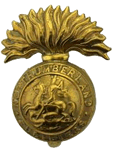Commemorated: | |||
| 1. Memorial: | Talana Farm Cemetery | III. K. 3. | |
| 2. Book: | The (1921) Masonic Roll of Honour 1914-1918 | Pg.120 | |
| 3. Memorial: | The (1940) Scroll - WW1 Roll of Honour | 45C GQS | |
Awards & Titles: | |||
Family :
Son of William and Ellen Davies. M.A., M.B., B. Chir. (Cambs), M.R.C.P. Capt. Frederick Charles Davies, buried in Ypres,1917, but the wooden cross placed on his grave in Ypres is now on the family grave in Garn cemetery AberystwythEducation & Career :
He was educated at St Paul’s School before matriculating at Downing in 1903 with an Entrance Scholarship.
He was a member of the College’s rugby team, and proceeded to his degree in 1906 by way of the Natural Sciences Tripos. He continued his medical studies at Charing Cross Hospital, where he was house-surgeon, house-physician and medical registrar.
He then went on to hold a variety of medical posts, including resident medical officer at Plaistow Fever Hospital, considered one of the most modern hospitals at the time which pioneered the barrier method of nursing infectious patients, bacteriologist of West Ham County Borough and medical officer of Battersea Tuberculosis Dispensary, 1912.
Service Life:
Campaigns:
- The First World War 1914-1918, World-wide.
| Unit / Ship / Est.: 9/Northumberland Fusiliers |
| Action : The Battles of Ypres 1917 (Third Ypres, or Passchendaele) |
31 July - 10 November 1917. By the summer of 1917 the British Army was able for the first time to fight on its chosen ground on its terms. Having secured the southern ridges of Ypres at Messines in June, the main attack started on 31st July 1917 accompanied by what seemed like incessant heavy rain, which coupled with the artillery barrages conspired to turn much of the battlefield into a bog. Initial failure prompted changes in the high command and a strategy evolved to take the ring of ridges running across the Ypres salient in a series of 'bite and hold' operations, finally culminating in the capture of the most easterly ridge on which sat the infamous village of Passchendaele. The Official History carries the footnote ?The clerk power to investigate the exact losses was not available? but estimates of British casualties range from the official figure of 244,000 to almost 400,000. Within five months the Germans pushed the British back to the starting line, which was where they had been since May 1915.
Detail :
Capt. Davies was killed in action during the Third Battle of Ypres (Passchendaele campaign) on 17 October 1917, aged 33, while attached to the 9th Northumberland Fusiliers. He is buried in Talana Farm Cemetery, but the wooden cross which originally marked his grave was relocated to the family grave in Garn cemetery, Aberystwyth.
Masonic :
| Type | Lodge Name and No. | Province/District : |
|---|---|---|
| Mother : | Lodge Che!re Reine No. 2853 E.C. | London |
Initiated | Passed | Raised |
25th January 1910 | 22nd March 1910 | 22nd October 1910 |
Junior Warden. Records of the United Grand Lodge of England for Chere Reine Lodge, show that he was "Killed in action 12 Oct 1917" and war service from 1916.
Source :
The project globally acknowledges the following as sources of information for research across the whole database:
- The Commonwealth War Graves Commission
- The (UK) National Archives
- Ancestry.co.uk - Genealogy, Family Trees & Family History online
- ugle.org.uk - The records of the United Grand Lodge of England including the Library and Museum of Freemasonry
Additional Source:
- Founder Researchers : Paul Masters & Mike McCarthy
- Researcher : Bruce Littley

